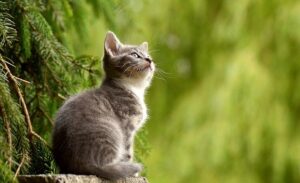It’s not uncommon for an 8-month-old cat to be much smaller than the average adult cat.
If your pet looks like she should be at least twice her size, you might have a miniature breed of feline in your home.
Size At a Glance
It’s not that your cat is abnormally small, but rather that she’s a member of a breed that starts out small.
There are many factors at work in determining how big a cat will get as an adult, including genetics, environment and diet.
Miniature breeds will have a genetic predisposition to being small.
While hairless breeds are born with a full set of hair, their hairballs, hairballs and food allergies may then cause the body to develop into a smaller shape.
While it’s not uncommon for an 8-month-old cat to be much smaller than the average adult cat, it does make it difficult for owners to recognize the signs of feline dwarfism.
If you think your cat is undersized at that age, here are some ways to tell if she’s truly a miniature breed.
The Difference in Body Shape
If your cat looks nearly identical to an adult cat, it’s very probable that she’s a full-size pet.
That may be the case if you have both an 8-month-old kitten and its parents in the house.
Powderpuff cats, which are rare in the United States, are described by their owners as miniature cats with large heads. This is actually a sign of feline dwarfism.
The most noticeable difference between a small breed and a larger one is the shape of the body.
If you have a pet that’s aged 8 months or more, compare her body with that of her mother or father. If she looks more like a kitten than they do, then breeding is not for her.
If you have an entire kitten family in your home, compare one adult cat to another adult cat from the same litter.
If it’s obvious that one member is much smaller than the rest, there’s a good chance that you have a miniature breed.
The Difference in Size
Because cat breeds come in so many different shapes and sizes, it can be difficult to accurately measure the size of an aging kitten.
By performing a few simple tests yourself, you can get a rough estimate of how big your pet will be as an adult and whether she has dwarfism.
The bottom of the front paws are an excellent indicator of how small your cat is.
Holding the front paws in your palm, measure the length between the wrists and the longest part of each toe. If you have a small cat, she should only be about 1.5 inches long.
The size of your pet’s head can also be a useful predictor of her adult proportions.
Lift your cat’s head with your fingers to see how big it feels in your hand. If it feels unusually light, you could have a miniature cat that is very small for her age.
Consider a DNA Test
If you think that you have a miniature breed, but aren’t sure, there are DNA tests available online that can help determine whether this is true or not.
DNA tests will tell you exactly what breed your kitten is, and most of them allow you to swab the inside of her cheek for a saliva sample.
It’s a quick and non-invasive method for finding out what kind of cat you have in your home.
The test can also reveal whether your cat may be genetically predisposed to dwarfism, though it does not definitively pinpoint the cause.
If you’re concerned at all about your pet’s size, talk to your veterinarian as soon as possible.
While there are certainly larger cats out there, your veterinarian will be able to give you important nutritional information about your pet.
A healthy diet can help your cat stay at a proper weight. This may be particularly important if you have a dwarf cat.
Excess weight can lead to other health issues like diabetes and arthritis, which are more common in small breeds of cats.
Top Tips For Pet Parents
If you notice that your cat’s limbs are shorter than the others, there’s a good chance that she has dwarfism. If this is the case, talk to your veterinarian about how best to care for her.
A healthy diet is the single most important thing you can do for your cat’s health.
Feeding your pet high-quality, nutrient-dense food will improve her chances of living a long and happy life.
When you buy food for your cat, make sure it’s the right kind. While some exotic pet owners like to provide their tiny cats with newfangled technology like tiny food dispensers and self-feeding bowls, these are all unnecessary complications.
Even cats who are considered miniature breeds still need food and water.
Even if she can’t consume enough food to meet her needs, a kitten that is small and healthy will weigh enough to feel full.
If you’re not sure how to choose the right cat food, speak with your veterinarian about recommended brands.
High-quality brands are formulated to meet the nutritional needs of growing cats, so it may be helpful to fill your cat’s bowl with dry food until she’s big enough for wet.
Foods that are high in fat and calories will make up a larger part of her diet early on, but will make up much less once she has reached full size.
You can also choose wet food if you have a cat with a sensitive stomach.
Don’t be alarmed if your kitten doesn’t eat for several days. It’s common for cats of any breed to lose their appetites when they’re young.
When your cat’s appetite begins to return, remember that it can take just as much food to keep a small cat healthy as it does for a large one.
She may need the same number of calories per cup of food as other cats, but physically, she can’t digest as much.
Don’t let your cat become obese.
Cat obesity is a real problem, and it can lead to many health problems later in life. Try not to overfeed her. Overfeeding can lead to diabetes and other weight-related issues.
If you’re concerned that your kitten may be too small for her age, talk to your vet about special foods that can help her grow.
It’s not unusual for veterinarians to recommend foods that are fortified with extra nutrients and calories to help a growing kitten.
These foods can be helpful if your pet is experiencing a growth spurt. They help her become larger and stronger more quickly.
Be sure to ask your vet about other ways that you can help your kitten grow up big and strong.
Vitamins and supplements can help your kitten stay healthy. Speak with a veterinarian about the best type of supplement for your pet’s age and health needs.
If you think that you have a dwarf cat, visit your vet as soon as possible. Your pet will need a full physical evaluation in order to determine if she’s truly too small for her age.
If she is, your veterinarian may recommend that you give your cat extra nutrients to help her grow up strong and healthy.
Putting These Tips To Work
Many of these are common sense suggestions, but it’s easy to overlook vitamins and minerals when you’re trying to take care of a pet.
Many of the best and most convenient supplements on the market today are fortified with extra vitamins and minerals that can help your cat feel her best.
If you’re concerned that your kitten isn’t growing fast enough, consider feeding your cat a high-quality supplement.
Dwarf cats aren’t as rare as you might think, and they can experience a variety of health issues just like any other breed.
Don’t let your cat’s small size fool you. Feeding her properly and keeping her in great health is vital to your pet’s health and wellbeing.
Final Thoughts
Dwarfism is a rare condition that features short limbs and small body size. I
f your cat is one of the millions in this group, talk to your veterinarian about the best ways to care for her.
One of the most important parts of taking care of a tiny cat is ensuring that she’s eating enough and giving her the vitamins and minerals that she needs.
A healthy, high-quality diet will help your pet grow large and strong.
Resources

